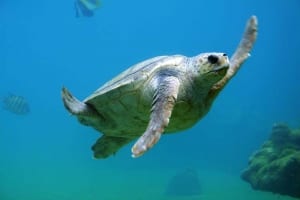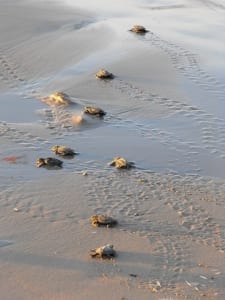
May 1st marks the OFFICIAL start of turtle season here along the Florida Gulf Coast.
Sea turtles are classified as a Protected Species under the Endangered Species Act. It is the responsibility of all residents and visitors alike to ensure that these delicate creatures are not exposed to anyharm, even ifinadvertent, while they nest and develop on our beaches.
Please use common sense and follow the rules below to help ensure safety for the sea turtles:
- Shield interior lighting and turn off exterior lights at night so as not to disturb the turtles' nocturnal activities
- Use turtle safe flashlights on the beach at night, such as a red LED light
- Do not use flashes when taking photos of turtles or nests (including flashes on cell phone cameras)
- Do NOT disturb any areas marked as nesting areas on the beach
- Remove ALLbeachequipment every evening
- Take every single thing you bring to the beach away with you. Leave no trash or any trace of your visit behind
- Do not, under ANY circumstance, touch turtles, nests, or hatchlings
- Don't dig trenches for hatchlings or otherwise disturb the natural terrain of the beaches. If you must dig, fill in any holes you create during your visit before you leave. Leave the beach as you found it.
- Leave NO plastic on the beach. No plastic bags, containers, caps, rings; do not use any products with micro-beads

Plastics are particularly dangerous to the recently hatched baby turtles as they make their arduous journey from their nest, across the sand to the ocean. After the babies exhaust their internal food supply from their yolk-sack, they instinctively will try to find food in the sand. The babies cannot distinguish their natural foods from tiny bits of plastic. Consuming plastic is one of the leading causes of death for both adult and baby sea turtles .The
Florida Coastal Conservancy is excited to have a brand new home in Port St. Joe, opening this Spring. Every May through October, the Conservancy sends out patrols of volunteers to monitor and track sea turtle activity along the Saint Joseph Peninsula. The Patrol tracks the movement of adult turtles coming ashore to nest and then counts and monitors the resulting nests. They then mark the nesting areas so that visitors to the beach leave them undisturbed. Once the eggs hatch, and the hatchlings head out to sea, the volunteers collect as much data as they can on the nesting site to be used for future conservancy. The new center will provide educationand exhibits about the areas most special and fragile visitors to help ensure the survival of these miraculous sea creatures.Remember, you are not the only visitors to our wonderful beaches. With a little bit of respect and attention, you can help keep our turtles safe and ensure the preservation of this ancient species for future generations to enjoy.
 May 1st marks the OFFICIAL start of turtle season here along the Florida Gulf Coast. Sea turtles are classified as a Protected Species under the Endangered Species Act. It is the responsibility of all residents and visitors alike to ensure that these delicate creatures are not exposed to anyharm, even ifinadvertent, while they nest and develop on our beaches.
May 1st marks the OFFICIAL start of turtle season here along the Florida Gulf Coast. Sea turtles are classified as a Protected Species under the Endangered Species Act. It is the responsibility of all residents and visitors alike to ensure that these delicate creatures are not exposed to anyharm, even ifinadvertent, while they nest and develop on our beaches. Plastics are particularly dangerous to the recently hatched baby turtles as they make their arduous journey from their nest, across the sand to the ocean. After the babies exhaust their internal food supply from their yolk-sack, they instinctively will try to find food in the sand. The babies cannot distinguish their natural foods from tiny bits of plastic. Consuming plastic is one of the leading causes of death for both adult and baby sea turtles .The Florida Coastal Conservancy is excited to have a brand new home in Port St. Joe, opening this Spring. Every May through October, the Conservancy sends out patrols of volunteers to monitor and track sea turtle activity along the Saint Joseph Peninsula. The Patrol tracks the movement of adult turtles coming ashore to nest and then counts and monitors the resulting nests. They then mark the nesting areas so that visitors to the beach leave them undisturbed. Once the eggs hatch, and the hatchlings head out to sea, the volunteers collect as much data as they can on the nesting site to be used for future conservancy. The new center will provide educationand exhibits about the areas most special and fragile visitors to help ensure the survival of these miraculous sea creatures.Remember, you are not the only visitors to our wonderful beaches. With a little bit of respect and attention, you can help keep our turtles safe and ensure the preservation of this ancient species for future generations to enjoy.
Plastics are particularly dangerous to the recently hatched baby turtles as they make their arduous journey from their nest, across the sand to the ocean. After the babies exhaust their internal food supply from their yolk-sack, they instinctively will try to find food in the sand. The babies cannot distinguish their natural foods from tiny bits of plastic. Consuming plastic is one of the leading causes of death for both adult and baby sea turtles .The Florida Coastal Conservancy is excited to have a brand new home in Port St. Joe, opening this Spring. Every May through October, the Conservancy sends out patrols of volunteers to monitor and track sea turtle activity along the Saint Joseph Peninsula. The Patrol tracks the movement of adult turtles coming ashore to nest and then counts and monitors the resulting nests. They then mark the nesting areas so that visitors to the beach leave them undisturbed. Once the eggs hatch, and the hatchlings head out to sea, the volunteers collect as much data as they can on the nesting site to be used for future conservancy. The new center will provide educationand exhibits about the areas most special and fragile visitors to help ensure the survival of these miraculous sea creatures.Remember, you are not the only visitors to our wonderful beaches. With a little bit of respect and attention, you can help keep our turtles safe and ensure the preservation of this ancient species for future generations to enjoy.


